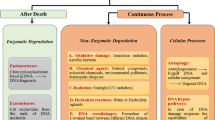Summary
DNA profiling is usually unproblematic when carried out on material sampled shortly after death. Prolonged postmortem intervals and improper storage cause significant DNA degradation, however there are instances where DNA analysis becomes necessary months after the autopsy. In such cases the investigator may be able to revert to material initially stored for toxicological purposes. In some cases such specimens undergo freeze-drying before storage. We have therefore tested DNA fingerprinting of freeze-dried postmortem material. It was found that freeze-drying is a suitable method for preserving tissue samples for DNA profiling.
Zusammenfassung
DNA-Untersuchungen gestalten sich im allgemeinen unproblematisch, wenn des Untersuchungsmaterial kurzfristig nach dem Tode entnommen wurde. Längere postmortale Intervalle Bowie inadäquate Lagerung können zu entscheidender DNA-Degradierung führen. Es finden sich aber immer wieder Fälle, wo sich die Notwendigkeit des DNA-Printing erst Monate nach der Sektion ergibt. Hier ist der Untersucher u. U. gezwungen, auf Material zurückzugreifen, welches ursprünglich für mögliche chemisch-toxikologische Untersuchungen asserviert worden war. Manchmal werden solche Proben vor der Einlagerung gefriergetrocknet. Aus diesem Grunde testeten wir die Möglichkeit des genetischen Fingerabdruckes an gefriergetrocknetem Leichenmaterial. Es ergab sich, daß die Technik der Gefriertrocknung auch in Hinblick auf DNA-Untersuchungen eine geeignete Probenvorbereitung ist.
Similar content being viewed by others
References
Bär W, Kratzer A, Mächler M, Schmid W (1988) Postmortem stability of DNA. Forensic Sci Int 39:59–70
Bär W (1989) Genetische Fingerabdrücke. Kriminalistik 5:313–318
Bär W, Kratzer A (1989) AbklÄrung strittiger Identität von Blutalkoholproben mit DNA-Fingerprinting. Z Rechtsmed 102:263–270
Biotest Diagnostics (1990) Manual B.E.S.T.-Probe MZ 1.3 Digoxigenin. Biotest AG
Brinkmann B (1988) Expertisen an biologischen Spuren. Z Rechtsmed 100:39–54
Echsel H, Racek M (1976) Biologische Präparationen. Jugend and Volk, München
Harries RH (1965) Vakuum- und Gefriertrocknung ganzer biologischer Objekte. Der Prdparator 11:244–252
Huckenbeck W, Müller H (1992) Use of the minisatellite probe MZ 1.3 for identification and assignment of dismembered corpses. In: Rittner C, Schneider PM (eds) Advances in Forensic Haemogenetics 4 (in press). Springer, Berlin Heidelberg New York
Huckenbeck W, Müller H, Prinz M (1992) Casuistic: Use of DNA fingerprinting in cases of affiliation without mother. In: Rittner C, Schneider PM (eds) Advances in Forensic Haemogenetics 4 (in press). Springer, Berlin Heidelberg New York
Ludes B, Tortel MC, Mangin P (1992) Use of PCR for forensic analysis of DNA from formaldehyde fixed and paraffin embedded human tissues. In: Rittner C, Schneider PM (eds) Advances in Forensic Haemogenetics 4 (in press) Springer, Berlin Heidelberg New York
Gill P, Jeffreys AJ, Werrett DJ (1985) Forensic application of DNA fingerprints. Nature 318:577–579
Oncor (1989) Sure blot: Southern-Dot Blot-Northern Protocols. ONCO R 605 Rev B
Ogata M, Mattern R, Schneider PM, Schacker U, Kaufmann T, Rittner C (1990) Quantitative and qualitative analysis of DNA extracted from postmortem muscle tissues. Z Rechtsmed 103:397–406
Pöche H, Wrobel G, Schneider V, Epplen JT (1990) DNAFingerprinting in Katastrophenfällen - Identifizierung einer Brandleiche (Hotelbrand mit 7 Opfern). (Abstract). Zentralbl Rechtsmed 34:415
Promega (1990) Protocols for nonisotopic DNA typing, Promega Corporation
Roewer L, Nürnberg P, Fuhrmann E, Rose M, Prokop O, Epplen JT (1990) Stain analysis using oligonucleotide probes specific for simple repetitive DNA sequences. Forensic Sci Int 47:59–70
Ross AM, Harding HWJ (1989) DNA typing and forensic science. Forensic Sci Int 41:197–203
Ross SR, Haites NE, Kelly KF (1990) Repeated freezing and thawing of peripheral blood and DNA suspension: effects on DNA yield and integrity. J Med Genet 27:569–570
Sprecher W, Berg S, Epplen JT (1990) Identifikation von Blutproben und foetalem Gewebe durch genetisches Fingerprinting. Arch Kriminol 185:44–51
Sprecher W, Kampmann H, epplen JT, Groß W (1991) Identifizierung einer Brandleiche mit Hilfe des DNA Finger-Printings. Rechtsmedizin 1:101–105
Steinmann WF (1982) Makroskopische Präparationsmethoden in der Medizin. Thieme, Stuttgart New York
Tonelli LA, Marcowicz KR, Anderson MB, Green DJ, Herrin GL, Cotton RW, Dykes DD, Garner DD (1990) Use of deoxyribonucleic acid (DNA) fingerprints for identity determination: Comparision with traditional paternity testing methods — part 1. J Forensic Sci 35:1265–1269
Yokoi T, Aoki Y, Sagisaka K (1989) Human identification and sex determination of dental pulp, bone marrow and blood stains with a recombinant DNA probe. Z Rechtsmed 102: 323–330
Author information
Authors and Affiliations
Additional information
Some contents of this paper were communicated as a poster at the 14th Congress of the International Society of Forensic Haemogenetics (Mainz, September 18–21, 1991)
Rights and permissions
About this article
Cite this article
Huckenbeck, W., Bonte, W. DNA fingerprinting of freeze-dried tissues. Int J Leg Med 105, 39–41 (1992). https://doi.org/10.1007/BF01371236
Received:
Revised:
Issue Date:
DOI: https://doi.org/10.1007/BF01371236




